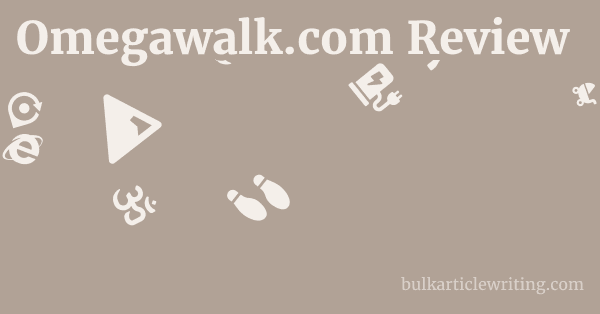Given the concerns regarding Omegawalk.com’s transparency and marketing practices, exploring reputable and ethical alternatives for footwear and activewear is essential.
Read more about omegawalk.com:
omegawalk.com Review & First Look
omegawalk.com Features
omegawalk.com Cons
When selecting alternatives, the focus should be on brands known for their established presence, clear corporate information, verifiable customer reviews, and a commitment to quality and ethical production.
These brands generally offer a more reliable purchasing experience and greater accountability.
Hoka
|
0.0 out of 5 stars (based on 0 reviews)
There are no reviews yet. Be the first one to write one. |
Amazon.com:
Check Amazon for omegawalk.com Alternatives Latest Discussions & Reviews: |
- Key Features: Renowned for its maximalist cushioning and Meta-Rocker geometry, which provides a smooth, propulsive ride. Offers exceptional shock absorption and comfort, making them popular for long-distance running, walking, and recovery. Diverse range for different foot types and activities.
- Price: High-range, typically $140 – $200.
- Pros: Superior cushioning and comfort, excellent for joint protection, wide range of models for various activities (road running, trail running, hiking, walking), widely recognized for performance.
- Cons: Higher price point, maximalist design might not appeal to everyone, some models can feel bulky.
Saucony
- Key Features: A long-standing brand in performance athletic footwear, known for its focus on biomechanics, fit, and advanced cushioning technologies like PWRRUN. Offers a comprehensive range of running, walking, and casual sneakers. Committed to sustainability and responsible manufacturing.
- Price: Mid-to-high range, typically $100 – $160.
- Pros: Excellent balance of cushioning and responsiveness, durable, wide variety of styles and support levels, strong reputation among runners and walkers, good ethical practices.
- Cons: Some models can be heavier than minimalist alternatives, styling might be considered conservative by some.
Altra
- Key Features: Unique for its FootShape™ toe box (allowing toes to splay naturally) and Balanced Cushioning™ (Zero Drop™) platform, which places the heel and forefoot at the same distance from the ground. This promotes a more natural foot strike and improved alignment.
- Price: Mid-to-high range, typically $120 – $160.
- Pros: Promotes natural foot mechanics, wide toe box enhances comfort and stability, excellent for preventing foot issues related to narrow shoes, good for long walks and runs.
- Cons: Zero Drop design requires an adjustment period for some users, aesthetics might not appeal to all, limited in formal or lifestyle shoe options.
ASICS
- Key Features: A global leader in athletic footwear, renowned for its GEL™ cushioning technology, which provides superior shock absorption. Offers an extensive range of shoes for various sports, including running, walking, and tennis. Known for its extensive research and development in sports science.
- Price: Mid-to-high range, typically $80 – $160.
- Pros: Exceptional cushioning and support, durable, wide array of models for different pronation types and activities, strong brand reputation for quality and performance.
- Cons: Some models can be heavy, design might be overly athletic for casual wear, price can be a barrier for some.
Patagonia (for Activewear & Ethical Practices)
- Key Features: A pioneer in ethical and sustainable outdoor apparel and gear. Offers high-quality, durable activewear, including base layers, jackets, and athletic bottoms. Known for its commitment to environmental causes, fair labor practices, and transparent supply chain.
- Price: High-range, typically $50 – $200+ for activewear.
- Pros: Industry leader in sustainability and ethical manufacturing, extremely durable products, excellent customer service and repair program, strong environmental advocacy.
- Cons: Higher price point, primary focus on outdoor and performance wear, less emphasis on urban or fashion-forward activewear.
Arc’teryx (for High-Performance Activewear)
- Key Features: Specializes in high-performance outdoor and activewear, known for its meticulous design, premium materials, and technical innovation. Offers durable, lightweight, and weather-resistant apparel for various intense activities. Focus on minimalist design with maximum functionality.
- Price: Very High-range, typically $100 – $400+ for activewear.
- Pros: Exceptional quality and durability, highly technical and functional designs, excellent weather protection, strong reputation for performance in demanding conditions.
- Cons: Very expensive, primarily geared towards outdoor and specialized athletic use, not a general activewear brand for casual wear.
Darn Tough (for Socks & Base Layers)
- Key Features: Specializes in incredibly durable and comfortable merino wool socks, offering a lifetime guarantee. Their socks are known for their fit, cushioning, and moisture-wicking properties, suitable for hiking, running, and everyday wear. Committed to ethical manufacturing in Vermont, USA.
- Price: Mid-range for socks, typically $15 – $25 per pair.
- Pros: Unmatched durability with a lifetime guarantee, superior comfort from merino wool, excellent moisture management and odor resistance, ethically manufactured in the USA.
- Cons: Limited to socks and base layers (no full activewear outfits), higher price per pair compared to mass-market socks.


Leave a Reply